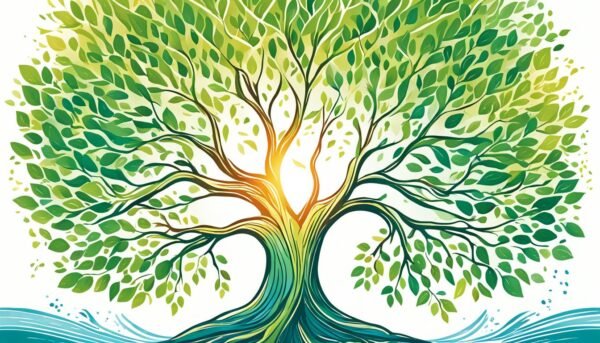Can mindfulness lead you to peace in a hectic world? We often search for guidance in our quest for calm. When ready to start a transformative journey, join me. We will explore mindfulness books and resources for solace and clarity.
I’ll show you books and resources loved by many seeking peace. These picks are based on their popularity on Goodreads. It’s a favorite site for book lovers.
Ready to explore mindfulness and its calming power? Let’s dive into wisdom and peace together.
Popular Mindfulness Books
We’ll look at some top mindfulness books here. These books are known for helping people feel calm inside. They include:
- Wherever You Go, There You Are by Jon Kabat-Zinn
- The Miracle of Mindfulness by Thich Nhat Hanh
- The Power of Now by Eckhart Tolle
- 10% Happier by Dan Harris
They talk about different parts of mindfulness. They show how to make mindfulness part of your daily life.
Book Summaries:
| Book Title | Author | Summary |
|---|---|---|
| Wherever You Go, There You Are | Jon Kabat-Zinn | This book serves as a guide on mindfulness meditation. It offers ways to be more aware and lower stress. |
| The Miracle of Mindfulness | Thich Nhat Hanh | It teaches mindfulness through simple practices. It shows how being truly in the moment is vital. |
| The Power of Now | Eckhart Tolle | This book dives into how living in the now can change your life. It offers ways to beat negative thoughts. |
| 10% Happier | Dan Harris | It tells the story of a news anchor finding peace through meditation. It shows how mindfulness adds to happiness and balance. |
These popular books share tips and ways to deal with daily life’s ups and downs. They help you find peace and happiness.
Mindfulness Resources

In this section, we explore various tools for your mindfulness journey. These include apps, websites, and guided practices. They help find peace in a busy world.
Mindfulness Apps
Mindfulness apps make it easy to practice daily. They offer guided meditations and exercises for calm and focus. Headspace and Calm are two popular ones. They have easy-to-use interfaces and many meditation programs.
Mindfulness Websites
For information and research on mindfulness, some websites are helpful. Mindful.org and the Greater Good Science Center have lots of content. They share articles, practices, and the latest studies. These sites give useful tips and insights for your mindfulness journey.
Guided Imagery and Affirmations
Guided imagery and affirmations are also great for mindfulness. They are offered by places like the UC San Diego Center for Mindfulness and the UCLA Mindful Awareness Research Center. These help with relaxation and well-being through visualizations and positive affirmations. They can deepen your mindfulness practice and enhance your experience.
Using mindfulness apps, websites, and guided practices, you get many resources to help your journey. They offer guidance, techniques, and inspiration. These tools help you find peace and clarity in your busy life.
Guided Imagery for Mindfulness
Guided imagery makes your mindfulness practice stronger. It uses your mind to focus on good images and ideas. This helps you change your thoughts and feel calm. Imagining things can make your mindfulness better and more enjoyable.
When you do guided imagery meditation, you picture in your mind calming scenes. This may include calming music or voices that help relax you more. These images help you feel more in the now and aware.
You can imagine many calming scenes in guided imagery. Pick images that mean something to you and your mindfulness goals. You might picture a quiet forest, a peaceful beach, or just feeling positive. This helps you feel more in the moment and relaxed.
Benefits of Guided Imagery for Mindfulness
Guided imagery for mindfulness has a lot of benefits. It helps your body, emotions, and mind.
- Enhanced relaxation: It lets you relax deeply, lowering stress and making you feel calm.
- Improved focus: Focusing on clear images teaches your mind to stay in the now.
- Heightened awareness: It makes you more aware of what you see, hear, and feel right now.
- Enhanced creativity: Using guided imagery boosts your imagination and creativity.
- Emotional healing: It gives you a safe place to face and heal from tough feelings.
- Increased self-awareness: It helps you understand your thoughts, feelings, and what you feel better.
To make your mindfulness better, use guided imagery. Here’s a picture to inspire you:
To get better at guided imagery, start with guides from places like the UC San Diego Center for Mindfulness and the UCLA Mindful Awareness Research Center. Try different images to see what works best for you. With practice, guided imagery can be a great tool for mindfulness. It can help you find more peace and wellness.
Mindfulness and Self-Compassion

When practicing mindfulness, adding self-compassion is key. Self-compassion means being kind and understanding to ourselves. It creates a caring space for growing and accepting ourselves. By mixing self-compassion with mindfulness, we build a kind relationship with ourselves. This helps improve our well-being.
Kristin Neff has helpful self-compassion meditations and exercises. These meditations help us be kinder to ourselves. They guide us in reflecting, soothing, and accepting ourselves.
Adding self-compassion to mindfulness lets us accept our flaws with kindness. We recognize and welcome our mistakes and flaws. This makes us more aware and accepting of ourselves, making us emotionally stronger and healthier.
The Benefits of Self-Compassion in Mindfulness Practice
Self-compassion in mindfulness brings many benefits. Treating ourselves with compassion, like we would a friend, supports our growth and healing. It helps us become more resilient.
- Reduced self-criticism: Self-compassion fights our inner critic, boosting self-acceptance and kindness.
- Increased emotional well-being: Practicing self-compassion enhances positive feelings and lessens negative ones, improving our emotional health.
- Enhanced self-care: Self-compassion encourages better self-care, leading to better physical and mental health.
- Improved resilience: Self-compassion helps us face challenges with acceptance and useful coping strategies.
Integrating Self-Compassion into Daily Mindfulness Practice
Here are tips to make self-compassion part of your daily mindfulness:
- Self-reflect: Daily, think about your thoughts and feelings kindly. Be compassionate even when facing hard times or feelings.
- Practice loving-kindness meditation: Try meditations that help you send love and good thoughts to yourself and others.
- Show self-compassion in difficult moments: Be kind and understanding to yourself during tough times. Offer yourself support and encouragement.
- Seek support: Join a supportive group or get help from a mindfulness expert or therapist to learn more about self-compassion.
| Key Elements of Self-Compassion in Mindfulness Practice | Benefits |
|---|---|
| Fostering self-acceptance and self-kindness | Reduces self-criticism and promotes emotional well-being |
| Nurturing positive emotions and reducing negative emotions | Enhances self-care and improves resilience |
| Prioritizing self-care and self-nourishment | Strengthens physical and mental health |
Conclusion
Mindfulness offers peace in busy times. By using books, guided imagery, and self-kindness, you’ll find calm. This helps your well-being and makes daily hardships easier.
Learning mindfulness takes time, so be kind and patient with yourself. Everyone’s journey is different. Find what works for you. Maybe it’s daily meditation, using apps, or reading books. Many resources are there to help.
Going deeper into mindfulness changes your mind and heart. It brings peace and makes every moment clearer. So, start practicing mindfulness today. See the big difference it makes in your life.
FAQ
How can mindfulness help me find peace in a frantic world?
Mindfulness practice offers a way to find peace in a busy world. Through books, resources, guided imagery, and self-compassion practices, you can feel calmer. These tools help improve well-being and make daily challenges easier to handle.
What are some popular mindfulness books?
Top picks include “Wherever You Go, There You Are” by Jon Kabat-Zinn. Also, “The Miracle of Mindfulness” by Thich Nhat Hanh, and “The Power of Now” by Eckhart Tolle. “10% Happier” by Dan Harris is another great choice. These books offer insights and techniques for everyday mindfulness.
What mindfulness resources are available?
Many resources can help on your journey to peace. Mindfulness apps like Headspace and Calm offer guided meditations. Websites such as mindful.org and the Greater Good Science Center provide articles and tools. UC San Diego Center for Mindfulness and UCLA Mindful Awareness Research Center have guided imagery and affirmations.
What is guided imagery for mindfulness?
Guided imagery uses the mind to focus on positive images. This helps change thinking patterns and brings calm. UC San Diego Center for Mindfulness and UCLA Mindful Awareness Research Center offer resources for guided imagery.
What is the connection between mindfulness and self-compassion?
Self-compassion is an important part of mindfulness. It means treating yourself with kindness and understanding. Kristin Neff’s guided meditations and exercises can help you be more self-compassionate. This helps build a kinder relationship with yourself.
Source Links
- https://www.goodreads.com/shelf/show/mindfulness
- https://www.marzanoresources.com/mindfulness-first.html
- https://healthlibrary.stanford.edu/books-resources/mindfulness-meditation.html
This post may contain affiliate links which means I may receive a commission for purchases made through links. I will only recommend products that I have personally used! Learn more on my Private Policy page.